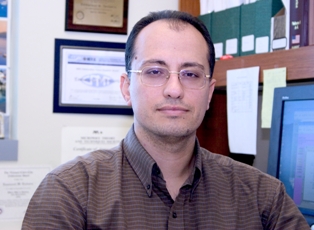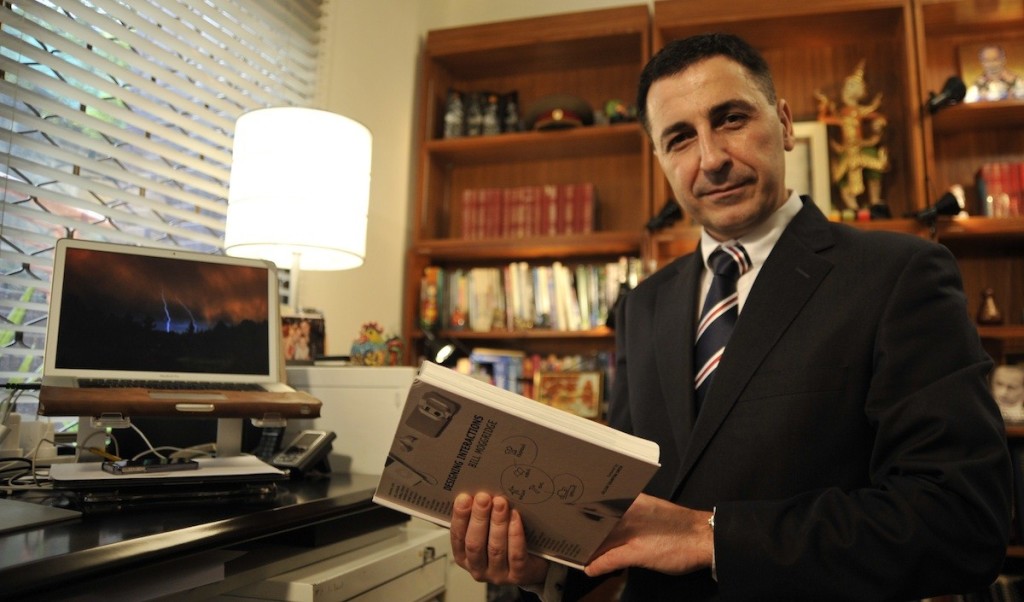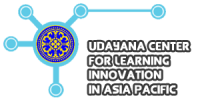Prof. Manos M. Tentzeris
The School of Electrical and Computer Engineering
Georgia Institute of Technology
Atlanta, GA 30332-0250

Professor Tentzeris was born and grew up in Piraeus, Greece. He graduated from Ionidios Model School of Piraeus in 1987 and he received the Diploma degree in Electrical Engineering and Computer Science (Magna Cum Laude) from the National Technical University in Athens, Greece, in 1992 and the M.S. and Ph.D. degrees in Electrical Engineering and Computer Science from the University of Michigan, Ann Arbor in 1993 and 1998.
He is currently a Professor with the School of ECE, Georgia Tech and he has published more than 550 papers in refereed Journals and Conference Proceedings, 4 books and 23 book chapters. He has served as the Head of the Electromagnetics Technical Interest Group of the School of ECE, Georgia Tech. Also, he has served as the Georgia Electronic Design Center, Associate Director for RFID/Sensors research from 2006-2010 and as the GT-Packaging Research Center (NSF-ERC), Associate Director for RF research and the leader of the RF/Wireless Packaging Alliance from 2003-2006. Also, Dr. Tentzeris is the Head of the A.T.H.E.N.A. Research Group (20 students and researchers) and has established academic programs in 3D Printed RF electronics and modules, flexible electronics, origami and morphing electromagnetics, Highly Integrated/Multilayer Packaging for RF and Wireless Applications using ceramic and organic flexible materials, paper-based RFID’s and sensors, inkjet-printed electronics, nanostructures for RF, wireless sensors, power scavenging and wireless power transfer, Microwave MEM’s, SOP-integrated (UWB, multiband, conformal) antennas and Adaptive Numerical Electromagnetics (FDTD, MultiResolution Algorithms). He was the 1999 Technical Program Co-Chair of the 54th ARFTG Conference and he is currently a member of the technical program committees of IEEE-IMS, IEEE-AP and IEEE-ECTC Symposia. He was the TPC Chair for the IMS 2008 Conference and the Co-Chair of the ACES 2009 Symposium. He was the Chairman for the 2005 IEEE CEM-TD Workshop. He was the Chair of IEEE-CPMT TC16 (RF Subcommittee) and he was the Chair of IEEE MTT/AP Atlanta Sections for 2003. He is a Fellow of IEEE, a member of MTT-15 Committee, an Associate Member of European Microwave Association (EuMA), a Fellow of the Electromagnetics Academy, and a member of Commission D, URSI and of the the Technical Chamber of Greece. He is the Founder and Chair of the newly formed IEEE MTT-S TC-24 (RFID Technologies). He is one of the IEEE C-RFID Distinguished Lecturers and he has served as one IEEE MTT-Distinguished Microwave Lecturers (DML) from 2010-2012.
Topic: “State of The Art Smart Green Technologies”
Prof. Daniel Churchill
The University of Hong Kong

Academic qualifications: PhD, Mlaw, MSc, BSc, BA
Previous academic positions held (with dates) :
- Lecturer (Learning Science and Technology) — from 2001 to 2004, Learning Sciences and Technology Academic Group, National Institute of Education, Nanyang Technological University, Singapore
- Instructional Design Specialist (E-learning) — from 1999 to 2001, Educational Technology Division, Institute of Technical Education, Singapore
- Lecturer (Multimedia Software Engineering) — from 1997 to 1999, Japan-Singapore Institute of Software Technology (JSIST), Singapore Polytechnic, Singapore
- Lecturer (Instructional Multimedia)/Course Coordinator — from 1994 to 1997, West Coast College of Technical and Further Education (TAFE), Western Australia
- Secondary School Teacher (Mathematics, Computing and Science) — from 1991 to 1993, Ministry of Education, Western Australia
Present academic position :
Associate Professor, faculty of Education, The University of Hong Kong (Since 2004)
Publication records :
- Churchill, D., Lu, J., Chiu, T., & Fox, B. (In press). Mobile learning design theories and application. Springer.
- Chiu, K. F. T., & Churchill, D. (2015). Exploring the characteristics of an optimal design of digital materials for concept learning in mathematics: Multimedia learning and variation theory. Computers & Education, 82 (2), 280–291.
- Churchill, D. (2014). Presentation design for “conceptual model” learning objects, British Journal of Education Technology, 45(1), 136-148
- Churchill, D., & Wang, T. (2014). Teacher’s use of iPads in higher education. Educational Media International, 51(3), 214-225.
- Churchill, D. (2013). Conceptual model design and learning uses. Interactive Learning Environments, 21(1), 54-67.
- Churchill, D. (2011). Web 2.0 in education: a study of the explorative use of blogs with a postgraduate class. Innovations in Education & Teaching International, 48(2), 149-158.
- Churchill, D. (2011). Conceptual Model Learning Objects and Design Recommendations for Small Screens. Educational Technology & Society, 14 (1), 203–216.
- Churchill, D. (2009). Educational applications of Web 2.0: using blogs to support teaching and learning. British Journal of Educational Technology, 40(1), 179-183.
- Churchill, D., & Hedberg, G. (2008). Learning object design considerations for small-screen handheld devices. Computers & Education, 50(3), 881-893.
- Churchill, D., & Churchill, N. (2008). Educational affordances of PDAs: a study of a teacher’s exploration of this technology. Computers & Education, 50(4), 1439-1450
Others (Award) :
- Outstanding Teacher Award 2011 (awarded by the University of Hong Kong)
- Distinguished Teacher Award 2008 (awarded by the Faculty of Education, The University of Hong Kong)
- Best Multimedia on the Web (Awarded by Macromedia)
Topics: “Learning Design and Digital Resources for STEM Education”
Prof. Ken Umeno
Graduate School of Informatics
Kyoto University, Japan
Ken Umeno (nickname: chaosken)
Professor at Graduate School of Informatics, Kyoto University, Japan. He was born in Nagoya, Japan just two years after the Japanese bullet train (Tokaido Shinkansen) began to operate between Osaka and Tokyo. He received his BSc degree in electronic communication from Waseda University, Japan, in 1990.
He received his MSc and PhD degrees in physics from the University of Tokyo, Japan, in 1992 and 1995, respectively. From 1998 until he joined Kyoto University as Professor in 2012, he worked for Japan’s Ministry of Posts and Telecommunications in its Communications Research Laboratory (currently National Institute of Information and Communications Technology, Japan). From 2004 to 2012, he was CEO and President of ChaosWare, Inc. From April of 2016, he is Visiting Professor at the Institute of Solid State Physics, the University of Tokyo, Japan. He received the LSI IP Award in 2003 and the Telecom-System Awards in 2003 and 2008 for his inventions on chaotic communications technology. He has dedicated to chaotic nature to make superefficient ICT and computing technology for more than 25 years.
Topic: “Green Chaos Technology for 5G, IoT and Cyber Security”









